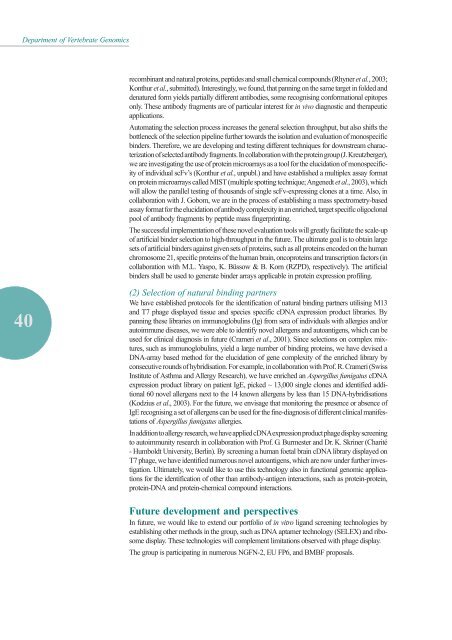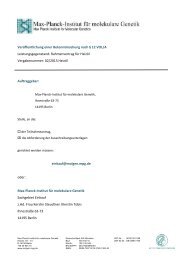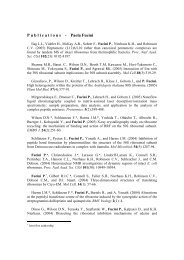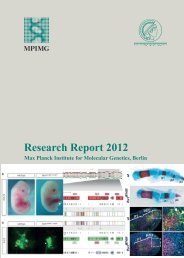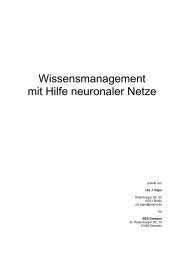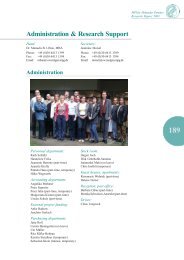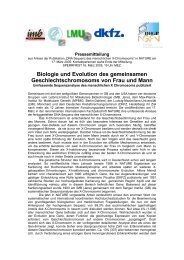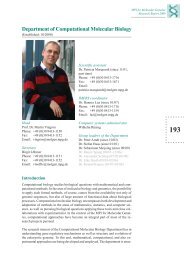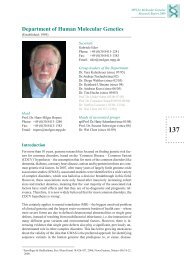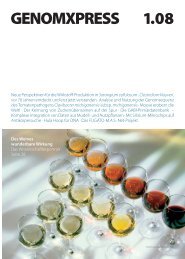Research Report 2003 - Max-Planck-Institut für molekulare Genetik
Research Report 2003 - Max-Planck-Institut für molekulare Genetik
Research Report 2003 - Max-Planck-Institut für molekulare Genetik
Create successful ePaper yourself
Turn your PDF publications into a flip-book with our unique Google optimized e-Paper software.
Department of Vertebrate Genomics<br />
40<br />
recombinant and natural proteins, peptides and small chemical compounds (Rhyner et al., <strong>2003</strong>;<br />
Konthur et al., submitted). Interestingly, we found, that panning on the same target in folded and<br />
denatured form yields partially different antibodies, some recognising conformational epitopes<br />
only. These antibody fragments are of particular interest for in vivo diagnostic and therapeutic<br />
applications.<br />
Automating the selection process increases the general selection throughput, but also shifts the<br />
bottleneck of the selection pipeline further towards the isolation and evaluation of monospecific<br />
binders. Therefore, we are developing and testing different techniques for downstream characterization<br />
of selected antibody fragments. In collaboration with the protein group (J. Kreutzberger),<br />
we are investigating the use of protein microarrays as a tool for the elucidation of monospecificity<br />
of individual scFv’s (Konthur et al., unpubl.) and have established a multiplex assay format<br />
on protein microarrays called MIST (multiple spotting technique; Angenedt et al., <strong>2003</strong>), which<br />
will allow the parallel testing of thousands of single scFv-expressing clones at a time. Also, in<br />
collaboration with J. Gobom, we are in the process of establishing a mass spectrometry-based<br />
assay format for the elucidation of antibody complexity in an enriched, target specific oligoclonal<br />
pool of antibody fragments by peptide mass fingerprinting.<br />
The successful implementation of these novel evaluation tools will greatly facilitate the scale-up<br />
of artificial binder selection to high-throughput in the future. The ultimate goal is to obtain large<br />
sets of artificial binders against given sets of proteins, such as all proteins encoded on the human<br />
chromosome 21, specific proteins of the human brain, oncoproteins and transcription factors (in<br />
collaboration with M.L. Yaspo, K. Büssow & B. Korn (RZPD), respectively). The artificial<br />
binders shall be used to generate binder arrays applicable in protein expression profiling.<br />
(2) Selection of natural binding partners<br />
We have established protocols for the identification of natural binding partners utilising M13<br />
and T7 phage displayed tissue and species specific cDNA expression product libraries. By<br />
panning these libraries on immunoglobulins (Ig) from sera of individuals with allergies and/or<br />
autoimmune diseases, we were able to identify novel allergens and autoantigens, which can be<br />
used for clinical diagnosis in future (Crameri et al., 2001). Since selections on complex mixtures,<br />
such as immunoglobulins, yield a large number of binding proteins, we have devised a<br />
DNA-array based method for the elucidation of gene complexity of the enriched library by<br />
consecutive rounds of hybridisation. For example, in collaboration with Prof. R. Crameri (Swiss<br />
<strong>Institut</strong>e of Asthma and Allergy <strong>Research</strong>), we have enriched an Aspergillus fumigatus cDNA<br />
expression product library on patient IgE, picked ~ 13,000 single clones and identified additional<br />
60 novel allergens next to the 14 known allergens by less than 15 DNA-hybridisations<br />
(Kodzius et al., <strong>2003</strong>). For the future, we envisage that monitoring the presence or absence of<br />
IgE recognising a set of allergens can be used for the fine-diagnosis of different clinical manifestations<br />
of Aspergillus fumigatus allergies.<br />
In addition to allergy research, we have applied cDNA expression product phage display screening<br />
to autoimmunity research in collaboration with Prof. G. Burmester and Dr. K. Skriner (Charité<br />
- Humboldt University, Berlin). By screening a human foetal brain cDNA library displayed on<br />
T7 phage, we have identified numerous novel autoantigens, which are now under further investigation.<br />
Ultimately, we would like to use this technology also in functional genomic applications<br />
for the identification of other than antibody-antigen interactions, such as protein-protein,<br />
protein-DNA and protein-chemical compound interactions.<br />
Future development and perspectives<br />
In future, we would like to extend our portfolio of in vitro ligand screening technologies by<br />
establishing other methods in the group, such as DNA aptamer technology (SELEX) and ribosome<br />
display. These technologies will complement limitations observed with phage display.<br />
The group is participating in numerous NGFN-2, EU FP6, and BMBF proposals.


